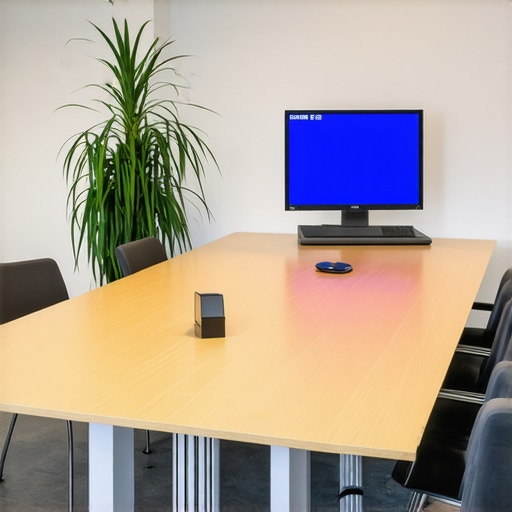My Personal Journey into Conference & Meeting Room Strategies for Startups
I still vividly remember my first startup pitch, tucked away in a modest coworking space. The atmosphere was buzzing, but it was the conference room setup that truly made or broke the vibe. That experience sparked my curiosity—how do the nuances of meeting spaces influence startup success? Over the years, I’ve explored various conference and meeting room strategies, and I want to share some insights that could help you elevate your startup game in 2024.
Why the Right Conference Space Can Make All the Difference
In my experience, selecting the perfect conference room isn’t just about size or aesthetics; it’s about fostering innovation and collaboration. I’ve seen startups thrive when they leverage flexible conference spaces that adapt to their evolving needs. For instance, flexible meeting rooms can be game-changers, offering an environment that encourages spontaneous brainstorming sessions or focused planning. This adaptability often leads to better team synergy and more creative problem-solving.
How to Maximize Productivity in Your Startup’s Conference Rooms
Maximizing productivity is a personal passion of mine. I’ve learned that utilizing dedicated conference spaces equipped with modern technology, like high-speed Wi-Fi and interactive whiteboards, can significantly boost efficiency. I recommend exploring proven strategies for conference room productivity. These include setting clear agendas beforehand and creating an environment free from distractions. It’s amazing how a well-designed space can elevate your team’s focus and output.
What Are the Future Trends in Meeting & Conference Spaces for Startups?
Looking ahead, I believe the future of conference rooms lies in innovation and sustainability. According to industry forecasts, we will see more coworking spaces transforming into collaboration hubs that blend technology and eco-friendly design. These spaces not only support productivity but also align with our growing environmental consciousness. I’ve personally started to incorporate these trends into my startup planning, and I encourage others to consider their long-term benefits.
Curious About How to Choose the Perfect Conference Room for Your Startup?
If you’re wondering how to select the ideal meeting space tailored to your startup’s unique needs, I recommend checking out this comprehensive guide. It’s packed with practical tips and real-world examples to help you make informed decisions.
Finally, I’d love to hear your thoughts! Have you experienced a breakthrough in your startup thanks to a strategic conference room setup? Share your stories in the comments or connect with me via contact. Let’s continue the conversation on how innovative meeting strategies can transform startup success in 2024 and beyond.
Rethinking Conference Rooms: Are Your Spaces Aligned with Startup Innovation?
As an entrepreneur or startup founder, your choice of meeting and conference spaces can significantly influence your team’s creativity and productivity. With the rapid evolution of coworking spaces, the focus is shifting from traditional meeting rooms to dynamic collaboration hubs that foster innovation. Have you considered how your current spaces support spontaneous ideation or strategic planning? Exploring creative coworking environments can reveal new opportunities to enhance your startup’s operational flow.
The Strategic Edge of Flexible Conference Spaces
Flexibility in meeting environments isn’t just a luxury; it’s a strategic necessity. Modern startups benefit from spaces that adapt to various activities—be it quick stand-up meetings, in-depth brainstorming sessions, or formal client presentations. According to industry leaders, leveraging flexible conference rooms can lead to higher engagement and innovative outcomes. Imagine a space that transforms seamlessly from a casual lounge to a high-tech presentation zone, supporting your team’s diverse needs and fostering a culture of agility.
Enhancing Productivity with Smart Meeting Technologies
In my experience, integrating cutting-edge technology into conference rooms is key to unlocking efficiency. High-speed Wi-Fi, interactive whiteboards, and seamless video conferencing tools create an environment where ideas flow freely. For startups aiming to optimize their meeting outcomes, exploring productivity strategies becomes essential. A well-equipped space minimizes disruptions, keeps the team focused, and accelerates decision-making processes, ultimately propelling your startup toward faster growth.
Future-Proofing Your Meeting Spaces: Trends to Watch in 2025
Looking ahead, the convergence of technology, sustainability, and design will shape the next generation of conference rooms. According to industry forecasts, coworking spaces will evolve into collaborative ecosystems that prioritize eco-friendly amenities and advanced tech integration. This shift not only enhances productivity but also aligns with the growing emphasis on corporate social responsibility. Incorporating these trends into your startup’s planning can provide a competitive edge and attract top talent eager to work in innovative, sustainable environments.

What are the critical factors to consider when designing a future-proof startup conference room?
From size and layout to technology integration and environmental impact, understanding these factors can help you select or design spaces that grow with your startup. For more insights, visit this comprehensive guide that offers practical tips and expert advice.
Have you experienced a breakthrough due to a strategic meeting space? Share your stories or ask questions in the comments below. For further assistance, feel free to contact us through our contact page. Let’s continue exploring how innovative conference environments can unlock your startup’s potential in 2024 and beyond.
Are Your Meeting Spaces Reflecting the Complexity of Modern Startups?
Over the years, I’ve come to realize that designing a conference room isn’t just about choosing furniture and tech—it’s about understanding the intricate dance of team dynamics, organizational growth, and technological evolution. As startups scale, their needs become more nuanced, often requiring adaptable spaces that can shift from collaborative hubs to quiet strategic zones. Reflecting on my own journey, I recall a pivotal moment when a flexible, thoughtfully designed conference space transformed a heated brainstorming session into a breakthrough innovation. This experience underscored how deeply our environments influence our capacity to think creatively and act decisively.
Can Your Conference Rooms Evolve with Your Startup’s Ambitions?
Many founders I’ve mentored ask, “How do I future-proof my meeting spaces?” The answer lies in embracing both innovative design and strategic foresight. Industry forecasts, like those from industry forecasts, suggest that the next wave of coworking environments will seamlessly integrate sustainability with cutting-edge technology, creating ecosystems that support both productivity and environmental responsibility. For instance, incorporating modular furniture that adapts to different activities or utilizing smart environmental controls can make your conference rooms more responsive to your evolving needs. It’s about creating a dynamic infrastructure that grows alongside your startup, not just a static space.
What Are the Subtle Elements That Make a Conference Room Truly Future-Ready?
Beyond size and tech, I’ve found that elements like acoustic design, lighting, and even scent can profoundly influence the quality of meetings. A well-placed acoustic panel can minimize distractions, while natural lighting boosts mood and focus. I recall experimenting with ambient lighting that adjusted based on the time of day, which subtly improved team alertness. These nuanced choices demonstrate that designing future-proof conference spaces requires a holistic approach—considering human psychology, technological integration, and sustainability. Exploring creative coworking environments reveals how innovative design can unlock new levels of collaboration.

How Can I Harness Technology to Elevate My Startup’s Meeting Culture?
Technology is the great enabler, but only when integrated thoughtfully. I’ve seen startups benefit from intuitive video conferencing tools that seamlessly connect remote and in-person participants, fostering inclusivity. Interactive whiteboards and real-time collaboration platforms turn traditional meetings into engaging workshops. For example, I experimented with digital brainstorming sessions that allowed remote team members to contribute asynchronously, leading to richer idea generation. As technology continues to evolve, the challenge is to stay ahead of the curve without overwhelming your team. Regularly revisiting your tech stack and gathering feedback can ensure your conference spaces remain both cutting-edge and user-friendly. For more insights, explore effective meeting space strategies.
How Do You Personally Experience the Impact of a Well-Designed Conference Space?
Sharing my own story, I remember a time when redesigning our startup’s conference room with flexible furniture and advanced tech led to a noticeable shift in team energy. Meetings became more vibrant, ideas flowed more freely, and decision-making accelerated. It taught me that investing in thoughtful design isn’t a luxury—it’s a catalyst for innovation. I encourage you to reflect on your own spaces: Do they inspire creativity and focus? Or do they hinder progress? Sometimes, small changes—like adding writable walls or adjusting lighting—can spark significant improvements. I’d love to hear your experiences, so please share your stories in the comments or reach out via contact page. Your insights might inspire others in our community.
The Subtle Art of Designing Resilient Conference Environments for Scaling Startups
As startups evolve rapidly, their meeting spaces must do more than just accommodate current team sizes—they need to anticipate future growth, technological advancements, and shifting organizational dynamics. I vividly recall implementing modular furniture systems in our conference rooms, allowing us to reconfigure spaces effortlessly for different team sizes or project needs. This flexibility proved invaluable during our scaling phase, ensuring that our environment remained conducive to innovation without incurring massive redesign costs. According to industry research, adaptable spaces not only support seamless growth but also foster a culture of agility and resilience, essential traits for startups aiming to compete in volatile markets.
Integrating Advanced Acoustic Design for Enhanced Cognitive Flow
One often-overlooked aspect of future-proofing meeting spaces is acoustic optimization. Poor sound management can derail even the most well-equipped rooms, leading to distractions and decreased productivity. I experimented with installing advanced acoustic panels and white noise systems, which significantly improved focus during complex strategic sessions. These enhancements create an environment where ideas can be exchanged freely without the interference of external noise, thus elevating the quality of discussions. For startups seeking to cultivate deep collaborative work, investing in nuanced acoustic solutions can be a game-changer. For more insights, explore creative coworking environments.
What Are the Cutting-Edge Technologies Reshaping Startup Meeting Cultures?
The integration of emerging technologies—such as augmented reality (AR), virtual collaboration tools, and AI-driven scheduling assistants—are transforming how startups conduct meetings. I recently tested an AR application that allowed remote team members to visualize prototypes in a shared virtual space, bridging the gap between physical and digital collaboration. These tools not only enhance engagement but also foster a sense of presence regardless of geographical barriers. To stay ahead, startups must continuously evaluate their tech stack, ensuring it aligns with their strategic goals and team workflows. Regular feedback loops and pilot programs can help identify the most impactful innovations. For a comprehensive overview, see effective meeting space strategies.
How Can I Cultivate a Culture of Innovation Through Space Design?
Creating an environment that sparks innovation requires more than technological investments—it demands intentional design choices. I found that incorporating elements like writable walls for spontaneous ideation, biophilic design to connect with nature, and versatile furniture arrangements encourages creativity. For instance, during a recent redesign, adding plant walls and adjustable lighting created a stimulating atmosphere that energized our team and prompted more daring ideas. These subtle yet impactful modifications demonstrate how thoughtful space design can serve as a catalyst for breakthrough thinking. I invite you to reflect on your current spaces—are they inspiring your team to think big? To explore further, visit creative coworking environments.

Are Your Meeting Environments Aligned with Your Long-Term Vision?
Strategic alignment between your startup’s vision and your meeting spaces is crucial for sustained growth. I learned this firsthand when we transitioned to a state-of-the-art, eco-friendly conference setup that reflected our commitment to sustainability—an aspect that resonated with our clients and team members alike. Incorporating green technologies, such as smart environmental controls and sustainable materials, not only demonstrated our values but also contributed to better air quality and energy efficiency. These investments may seem subtle but can significantly impact your brand perception and operational sustainability. For detailed guidance, review this comprehensive guide.
How Do Nuanced Design Elements Influence Team Dynamics and Innovation?
Elements like natural lighting, ambient scent, and comfortable ergonomic furniture subtly influence mood and focus. I experimented with circadian lighting patterns that adjusted throughout the day, which noticeably improved team alertness and morale. These refined touches, though often overlooked, create an environment where your team can perform at their best. To deepen your understanding of creating such holistic spaces, explore creative coworking environments.”},
Things I Wish I Knew Earlier (or You Might Find Surprising)
1. The Power of Flexibility
One lesson I learned the hard way is that rigid conference rooms can stifle creativity. Early in my startup journey, I underestimated how adaptable spaces could influence collaboration. When I finally embraced flexible environments—like movable furniture and multi-purpose zones—our team’s innovation skyrocketed. It’s a game-changer that’s often overlooked.
2. Technology as an Enabler, Not a Distraction
I used to think high-tech gadgets were a luxury. Now I see them as essential. Integrating seamless video conferencing and interactive whiteboards transformed our meetings into engaging, productive sessions. The key is thoughtful tech adoption—don’t overwhelm, but empower your team to thrive.
3. Design Matters More Than You Think
Small touches, like natural lighting or acoustic panels, profoundly affect meeting quality. I experimented with ambient lighting and noticed a boost in team mood and focus. Sometimes, subtle design choices make the biggest difference, turning ordinary spaces into innovation hubs.
4. Future-Proofing Is a Continuous Process
As startups grow, their needs evolve. I found that modular furniture and smart environmental controls helped us adapt quickly. Investing in adaptable spaces isn’t just smart—it’s necessary for sustained success. Trends like eco-friendly tech also play a crucial role in staying ahead.
5. The Human Element Is Still Key
Despite all the tech and design, the real magic happens when people feel comfortable and inspired. Creating spaces that foster a sense of belonging and creativity encourages your team to do their best work. Never underestimate the power of a well-designed environment to build culture.
Resources I’ve Come to Trust Over Time
- Coworking Central: A goldmine for innovative workspace ideas and strategies. Their articles helped me understand the importance of adaptable conference rooms. Highly recommend exploring their content to stay inspired.
- Harvard Business Review: Offers deep insights into organizational culture and space design. Their research-backed articles provided a solid foundation for my design choices.
- Fast Company: Focuses on future trends in workspaces and innovation. Their reports on sustainable coworking spaces kept me informed about emerging trends.
Parting Thoughts from My Perspective
Reflecting on my journey, I realize that the most impactful takeaway is the importance of intentional space design in fostering startup success. As we approach 2024, embracing flexible, technology-enabled, and human-centered conference rooms will be vital. These environments aren’t just venues—they’re catalysts for innovation and growth. If this resonates with you, I’d love to hear your thoughts or stories. Feel free to share or reach out; let’s keep the conversation going and continue to learn from each other’s experiences in creating inspiring startup spaces.
